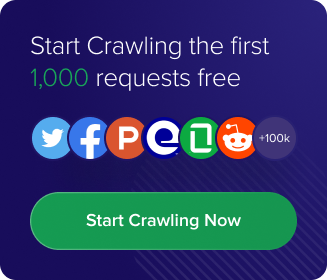Scraping websites in 2025 is no longer what it used to be. Gone are the days when a simple script could grab a page’s HTML and call it done. Today, most websites are dynamic, loaded with JavaScript, and often present. To obtain reliable data, obstacles can arise that can turn even a routine task into a headache. If you want data reliably, you need more than just code. You need a scraper that actually keeps up.
The challenge? Almost every tool out there claims to be fast, accurate, and endlessly scalable. It’s challenging to determine which ones will truly deliver without incurring more costs than expected. To cut through the noise, we took a close look at six popular solutions: Crawlbase, Zyte, ScrapingBee, Octoparse, Apify, and ScraperAPI. We examined them across pricing, reliability, speed, and usability, so you can see which platform really stands up to real-world scraping demands.
1. Crawlbase
Crawlbase has built its reputation as the best web scraper in 2025. It provides developers with a simple API that handles proxies, CAPTCHA, JavaScript rendering, and scaling while maintaining transparent, pay-per-success pricing.
Ease of use
Getting started takes minutes. You can fire a single API call and instantly receive HTML or a fully rendered page if the site is built with JavaScript. For developers who’d rather spend time processing data instead of managing infrastructure, this approach saves a lot of mental load.
Performance
Highly optimized with 20 requests per second allowed by default, and can be scaled up anytime. The average response time is quick, and success rates consistently rank among the highest in the industry. For high-volume crawls, the Enterprise Crawler lets you queue thousands of URLs asynchronously, which helps maintain speed without crashing your system.
Features
Crawlbase isn’t just a single tool; it’s a robust solution. It includes multiple products that handle different levels of web crawling, from one-off requests to large asynchronous jobs. The Crawling API and Enterprise Crawler are designed for scalability, while Smart AI Proxy enables direct integration into custom setups. Across all products, you receive exceptional crawling capabilities, including automatic JavaScript rendering, CAPTCHA bypass, intelligent proxy rotation, and structured JSON output for supported sites.
Pricing
Crawlbase keeps things simple. You pay only for requests that actually go through. Anything that fails or gets blocked won’t cost you anything. Each domain has its rate listed via the publicly available pricing calculator, so there’s no guessing or hidden fees. Planning is easy, and you don’t have to worry about unexpected charges. Honestly, most scraping tools aren’t this upfront.
Verdict: It’s rare to find something this flexible. Crawlbase works for big enterprise projects but isn’t overkill for a solo developer either. Clear pricing, reliable performance, and solid support make it one of the most practical scraping APIs you can use today.
2. Zyte
Zyte is designed for ease rather than control. Perfect if your main goal is to pull data quickly and move on, rather than spending hours fine-tuning proxy or browser settings. Based on our previous Zyte comparison, here’s a quick summary of its capabilities:
Ease of Use
Everything runs in the cloud, so setup is painless. You can deploy spiders, check logs, and manage projects from the dashboard with almost no server work. That convenience does have a ceiling, though. Once you want to customize behavior or optimize parsing logic, you’ll notice the limitations pretty quickly.
Speed & Reliability
Zyte handles small and mid-sized crawls well. Larger jobs, especially those that rely on JavaScript rendering, can experience noticeable slowdowns. The results are usually clean, but not always complete; you’ll easily find product names and prices, yet reviews or in-depth metadata may not be available.
Pricing & Features
At first glance, the pricing appears fair, at roughly $50 per 100k HTML requests to Amazon. However, real-world projects often push costs higher once dynamic pages are introduced, sometimes approaching $200. Tools like Scrapy Cloud and AI Scraping make it beginner-friendly, although more advanced users may find the platform somewhat restrictive.
Verdict: Zyte is the sort of scraper that works best when you want something stable and low-effort. It’s dependable for lighter workloads but starts to feel restrictive once scale or complexity enters the picture.
3. ScrapingBee
It’s one of those tools that make web scraping feel effortless. It’s fast to start with, but it’s not really built for people who like to tweak things under the hood. Here’s our conclusion based on the previous ScrapingBee comparison we’ve published:
Ease of Use
Everything runs through a simple API call. It’s ideal for small projects or one-time, clean jobs. But once you start working with complex or dynamic sites, you’ll quickly hit the ceiling on flexibility.
Performance
Speed is fine for static pages, although things slow down when JavaScript rendering is enabled. Data quality is generally good, but lighter modes sometimes omit additional details, such as reviews or images.
Pricing
The entry plan costs around $49 per month for 250,000 credits. Each feature requires more credits, so costs increase rapidly as you scale. It’s manageable for small projects, but tricky to budget long-term.
Verdict: ScrapingBee is suitable if you just need something quick that works. It’s best suited for small or medium scraping jobs where convenience matters more than deep customization or large-scale performance.
4. Octoparse
As discussed on our Octoparse comparison, they have been the go-to scraper for people who don’t want to write code. You point, click, and it starts collecting data. The visual workflow makes it easy for beginners to pull information from various sites. Here’s a quick rundown:
Ease of Use
Everything runs through a drag-and-drop interface. It’s quick to set up and doesn’t ask for much technical knowledge. The trade-off is that once you encounter complex or dynamic websites, it may require some adjustments to make things run smoothly.
Performance
On light pages, Octoparse processes data quickly, with hundreds of rows per minute, sometimes more. Once JavaScript or logins get involved, speed drops and results may need cleanup. The platform’s cloud version remains fairly reliable, although performance can fluctuate depending on the load and configuration.
Pricing
The Standard plan starts at around $83 per month, which includes up to three concurrent tasks. It’s suitable for small to medium-sized projects, but larger crawls may require additional add-ons, such as residential proxies or CAPTCHA bypass, each with separate fees. Those extras can make the real cost higher than it first appears.
Verdict: It is ideal if you want something simple and visual. It’s user-friendly and handles basic scraping jobs well. But if your project grows or involves tricky JavaScript-driven pages, you might eventually feel the limits of its flexibility.
5. Apify
Apify is a full automation platform built around what it calls “Actors.” These are modular scripts that can scrape, process, or even interact with websites in complex ways. As discussed on our Apify comparison, it’s great for developers who want total control, but it can also make things heavier than they need to be.
Ease of Use
You don’t just press a button with Apify. You design or customize Actors, manage Compute Units, and monitor how your tasks perform. For someone new, the setup can feel a bit like assembling your own machine. However, once you get the hang of it, it becomes powerful and flexible.
Performance
Apify runs everything on its own infrastructure, and performance is solid once it is properly configured. Jobs usually execute within seconds, but longer, JavaScript-heavy scrapes can run into slowdowns.
Pricing
Apify uses a Compute Unit model. You pay for the machine time your jobs consume. It’s flexible, but not always predictable. Their Starter plan starts at $39 per month, while the Scale and Enterprise tiers increase in cost depending on resource usage.
Verdict: Apify works best for developers who want to build custom, reusable scrapers with automation built in. But for quick data collection or projects that prioritize simplicity, its layered setup can feel more like a commitment than a convenience.
6. ScraperAPI
ScraperAPI is often the go-to choice for individuals who want to access data quickly without setting up a full-scale scraping infrastructure. It handles proxy rotation and CAPTCHA, and returns the page in HTML or JSON format. Here’s the quick rundown from our previous ScraperAPI comparison:
Ease of Use
It’s about as plug-and-play as it gets. You point your request at their endpoint, include your API key, and you’re scraping. However, if you’re trying to handle custom headers, session logic, or specialized retries, you’ll hit a few limits.
Performance
For small or mid-sized jobs, ScraperAPI runs smoothly. But once you start loading heavier tasks or sites that use a lot of JavaScript, it can slow down. The success rate holds up fairly well, although it can slip a bit with sites that have more stringent anti-bot systems, such as Google or Amazon.
Pricing and Features
Their plans start at around $49 per month for 250,000 requests and increase from there. The pricing is per request, so the real cost can add up when dealing with tricky targets. It supports JavaScript rendering and geolocation options, but you’ll still need to write your own parsers to structure the data you get.
Verdict: ScraperAPI is fine if you just need quick access to web pages without worrying about proxies. It’s easy to set up and works well for smaller projects. Once you start scaling or need very stable success rates, though, you might notice its limits.
Quick Feature Comparison
| Feature | Crawlbase | Zyte | ScrapingBee | Octoparse | Apify | ScraperAPI |
|---|---|---|---|---|---|---|
| Success-based pricing | ✅ | ✅ | ✅ | ❌ | ❌ | ✅ |
| Pay-as-you-go | ✅ | ✅ | ❌ | ❌ | ✅ | ❌ |
| Pricing transparency | ✅ Clear per-domain rates, no hidden fees | ❌ | ❌ | ✅ | ✅ | ❌ |
| Proxy rotation | ✅ | ✅ | ✅ | ✅ | ✅ | ✅ |
| CAPTCHA bypass | ✅ | ✅ | ✅ | ✅ | ✅ | ✅ |
| JavaScript rendering | ✅ | ✅ | ✅ | ✅ | ✅ | ✅ |
| Cloud storage | ✅ Integrated | ✅ | ❌ | ✅ | ✅ | ❌ |
| Structured data output | ✅ Ready-made for 20+ popular sites | ✅ | ✅ | ✅ | ✅ | ✅ |
| Scalability | Unlimited: from small crawls to enterprise scale | High | Medium | Medium | High | Medium |
| Ease of setup | ✅ One-line API call | ✅ Easy | ✅ Easy | ✅ No-code | ❌ Dev setup | ✅ Simple |
| Ideal for | Any scale, JS-heavy or high-volume projects | Quick jobs, light customization | Static or simple sites | Non-coders | Developers | Mid-scale scraping |
Final Thoughts
Every API has its place. But if you’re the kind of developer who cares about speed, success rates, and actually knowing what your bill will look like, Crawlbase is the best web scraper API in 2025. It balances simplicity with real power, handles JavaScript-heavy pages, rotates proxies automatically rotates proxies, and scales without turning your budget into a guessing game.
The truth is, in web scraping, the “best” API isn’t about flashy features or the price tag. It’s the one that delivers quality web scraping projects. Try Crawlbase now and see why it stands out for exactly that reason.









